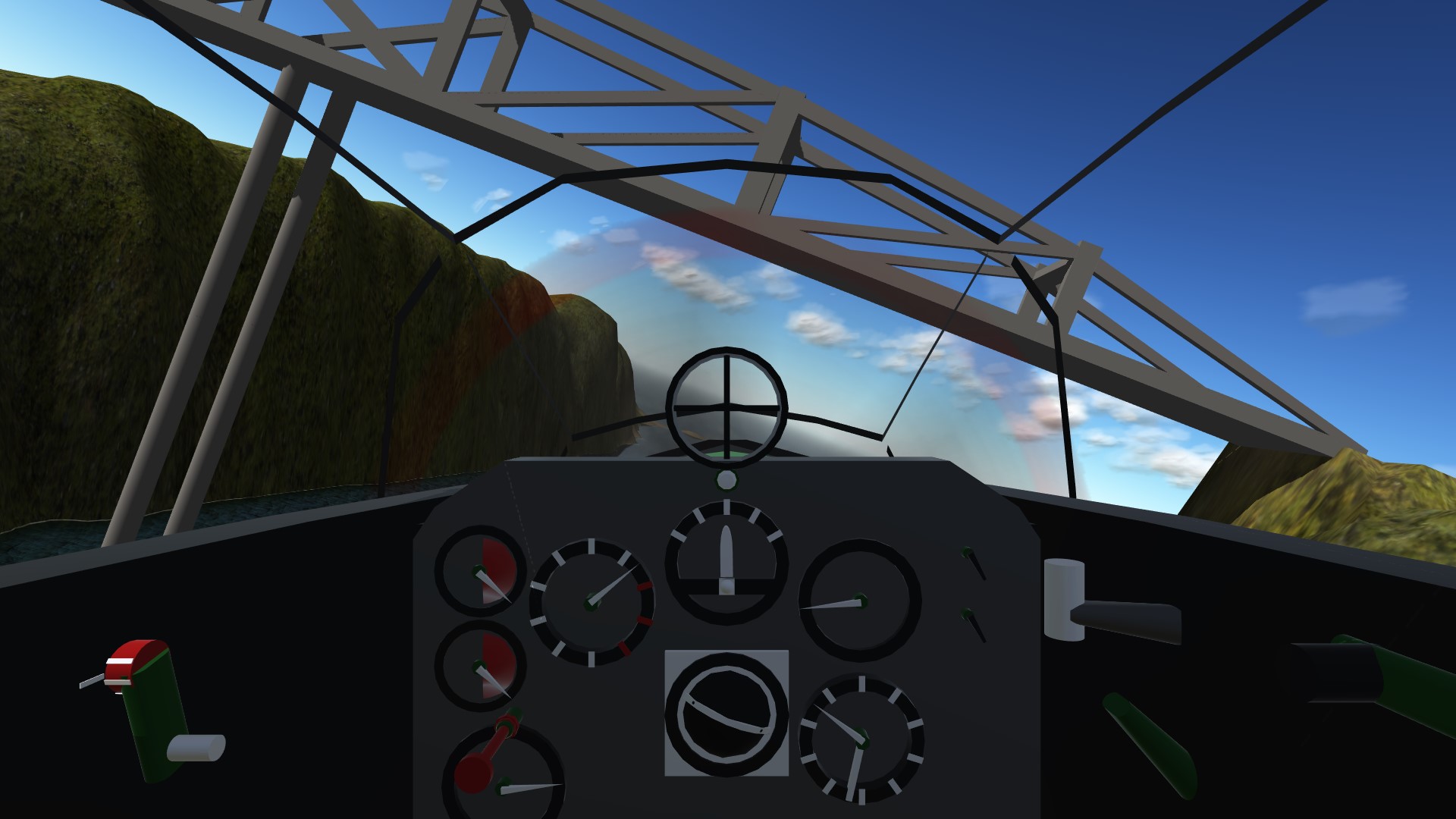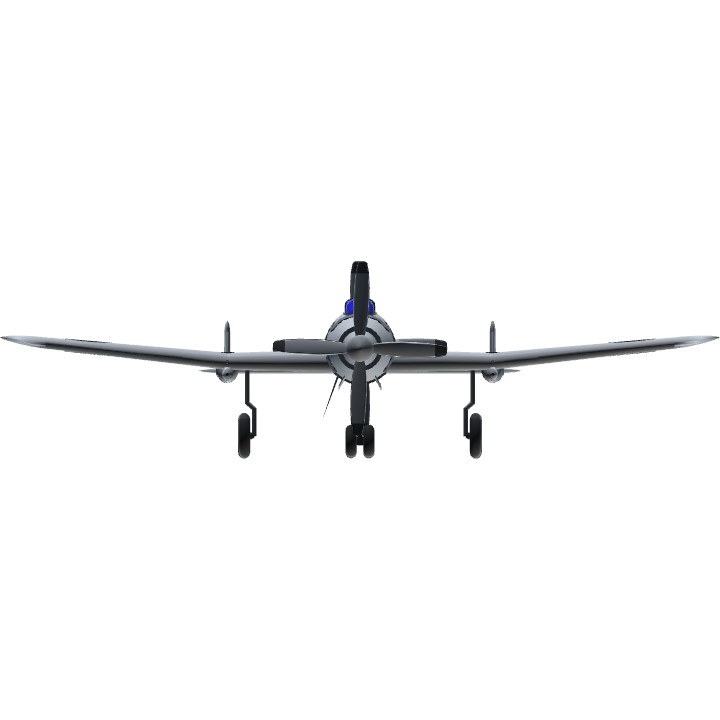Credit: The aircraft being blown apart on the first upload screenshot is Phoza's P-51D-15-NA "Notre Dame"
Features:
Good flying performance
Outstanding firepower
Somewhat realistic instruments and detailed cockpit
Realistic and semi-historical paint job
Good for both WWII dogfight and WWII torpedo bomber challenge
Aircraft History:
Tachikawa Aircraft began researching for a new high-altitude interceptor in early 1943, which resulted in this tandem-engined, push-pull configuration design. The design was deemed to unconventional and too dangerous in the event the pilot intends to bail out, so the design was modified into a far more conservative Ki-94-II design.
The Ki-94-I was a tandem-engine high-altitude interceptor, with very good speed performance, altitude performance and firepower. It was to be powered by two Ha-211-Ru with two-stage, two-speed turbosuperchargers, and was to be armed with two 30mm Ho-155-II autocannons and two 37mm Ho-204 autocannons.
About the Livery:
Th 54th Squadron (Flying 54th Sentai) was a fighter squadron in the Imperial Japanese Army. Historically it first participated in the Chinese campaign, and then was charged with the defense of northern Japan in the final stages of the war. The squadron features an origami insignia on the bottom of the vertical stablizer and extends to part of the tail cone.
This particular aircraft bears the livery of Yellow-1, i.e. the flight leader of the 2nd flight in the 54th squadron. Some IJAAF pilots would name their aircraft, and for this one it is named Katana (written on the vertical stablizer).
The aircraft bears four kill marks, all of which seem to be shot down instead of achieved by ramming. IJAAF has distinct kill marks for ramming kills (a red fighter would be painted obliquely above the bomber icon), however, given the sensitivity about the subject of suicidal attacks in Japanese community, I chose to take out the historical reference of "special attack" (tokkou, suicidal attack in Japanese) on this plane. After all, who needs ramming when you have such firepower?
Controls:
Normal flight controls, manual propeller pitch.
VTOL: pitch (not reversable, all the way down for zero pitch, all the way up for 100%)
AG1:flap
AG2: cowling flap (adjusted automatically)
AG3: Oo-pai (Japanese term for Autopilot, no, it's not Oppai.)
AG8: Engine ignition.
Guns: 30mm Ho-155-II
Cannons (available both in air to air and air to ground): 37mm Ho-204 (100 rounds each)
Both the guns and the cannons converges at 2km.
Note:
Overspeed warning goes off at 700 km/h IAS (winch sound)
Stall/high AoA warning goes off at 15 degrees angle of attack (also winch sound)
IMPORTANT: In order to achieve the fastest turn speed, control your elevator so that it does NOT trigger the stall warning. This actually allows it to turn faster than going all the way.
There's a warning light( actually a piston on top-right of the altimeter, it would be triggered when you are less than 150m from the ground and landing gear not extended)
There's also a white warning light in the fuel gauge which would light up when you have less than 20% fuel left.
Suggested landing speed: Gear down at 380 km/h, flap down at 250 km/h, touchdown at 180-210 km/h.
Note that landing gears are (historically correctly) asymmetrically retracted/extended, it would take longer to actually extend all the landing gears.

^middle section of the cockpit

^left side of the cockpit, note that the pitch lever has markings to facilitate flying with HUD off.

^right side of the cockpit
if you have trouble seeing the pictures please tell me.
Specifications
Spotlights
- StockPlanesRemastered 5.9 years ago
- Thelegitpilot13 5.9 years ago
- Typhoon03 5.9 years ago
- UraniumOxide 5.9 years ago
General Characteristics
- Created On Windows
- Wingspan 52.0ft (15.8m)
- Length 47.5ft (14.5m)
- Height 14.2ft (4.3m)
- Empty Weight 9,116lbs (4,135kg)
- Loaded Weight 10,667lbs (4,838kg)
Performance
- Horse Power/Weight Ratio 0.417
- Wing Loading 25.3lbs/ft2 (123.7kg/m2)
- Wing Area 421.1ft2 (39.1m2)
- Drag Points 3914
Parts
- Number of Parts 321
- Control Surfaces 6
- Performance Cost 1,976










@asteroidbook345 Ah that's standard equipments for modern airliners, and it's as a backup, unlike for the 163 it's the main source of power.
Very nice!
@CAFMK Only if I find a way to reverse the landing gear sequence.
couldyou buil n1k fighter?
@asteroidbook345 I think the little fan for Stuka is the Jericho siren... but yup, Me-163's fan was indeed the generator.
I think some modern electronic warfare pods also have similar designs...
@asteroidbook345 Nah I think it was deliberately made to only retract one side at a time, probably with a valve or sth.
That being said, the original N1K-J had two-stage retracting landing gears. The main gears would first compress its own pistons (making the legs shorter) before actually rotating and storing itself into the wing. This has to be (at least partially) hydraulic, at least the shortening part has to be hydraulic.
@asteroidbook345 Yeah now that you mentioned it, Japanese landing gears usually don't have visible pistons, so they are probably electric.
WWII planes have relatively limited ability to generate electricity. This was a problem that stopped many planes from using gattling guns, and the reason why the Germans chose revolver cannon (MG213) which later became the prototype of many post-war aircraft guns (DEFA 55X series, ADEN, M39 and BK-27)
@asteroidbook345 Actually I don't think WWII Japanese planes use hydraulic... It's more likely that Japanese electric systems cannot afford both legs to operate at the same time. If you go take a look on actual Zero fighters' takeoff clips, you will notice that they will retract the left leg first, then the right.
For P-51 Mustangs, on the other hand, the both legs would almost retract simultaneously, albeit with some inevitable difference in exact timing.
Very cool!
@FranzPeterSiegfried
@MrACEpilot
likewise
@CrashFighter05
@edensk
@IStoleYourMeme
likewise
@Tonnkatu500
@Strikefighter04
@Treadmill103
You are tagged for your upvote in the last video teaser.